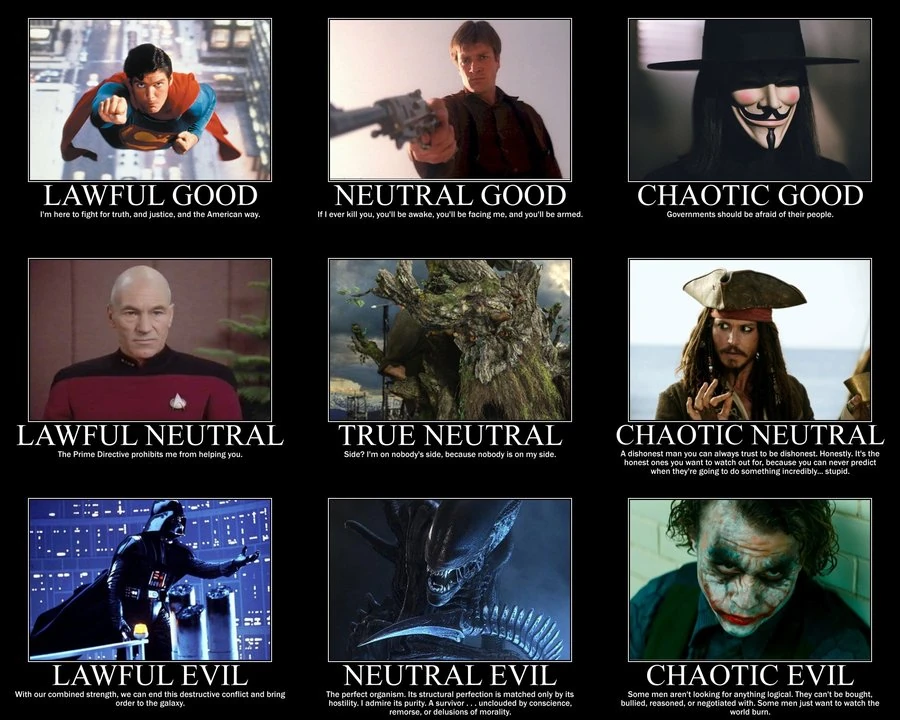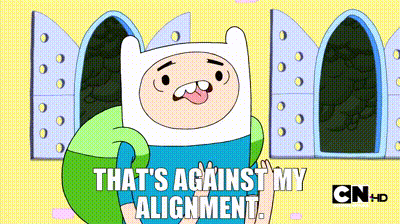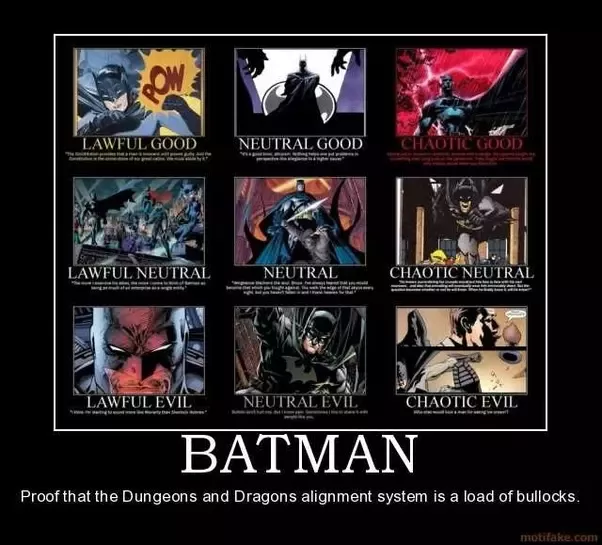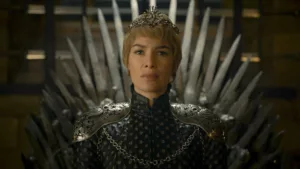Alignment is a system that Dungeons and Dragons’ creators introduced in 1974 and refined in 1979. The two axes that alignment runs along are Good-Evil and Lawful-Chaotic, with Neutral fitting in between the two poles of each axis.
Choosing an alignment can be a helpful starting point to guide your roleplaying and character’s decision-making process. But many players opt not to choose an alignment at character creation, instead waiting to see how their character organically behaves in the DM’s universe and alongside their party members.
In any case, alignment has little to no influence on actual gameplay mechanics in DnD 5e. Some effects interact with alignment (e.g., Detect Evil and Good), but it’s not like old school DnD, where a Paladin literally must be Lawful Good, or a Druid must be True Neutral.
But to help understand what each alignment means, I’ve explained each of the nine alignments, along with examples of notable characters who belong in each alignment.
Law vs. Chaos
The axis of Lawful vs. Chaotic measures a character’s adherence to external rules and codes.
Lawful characters tend to prioritize external principles, whether they be societal laws, organizational rules, or personal codes of conduct.
On the other hand, Chaotic characters value their personal freedom and tend to follow their instincts and immediate desires rather than adhering to a predefined structure.
Lawful Alignment:
Lawful characters thrive on order, structure, and external rules. They often have a strong sense of duty and honor, following a set code that guides their actions. This code could be based on societal laws, the tenets of an organization (like a guild or a religious order), or a personal oath. Lawful characters may still break specific laws if they conflict with their own code, but they generally seek a structured and principled approach to decision-making.
Examples of Lawful behavior include following religious tenets, adhering to the guidelines of a thieves’ guild, or acting on the orders of a superior without question.
Chaotic Alignment:
Chaotic characters prioritize freedom, individuality, and the pursuit of their own desires over rigid adherence to external rules. They often act on their instincts, whims, or personal motivations rather than following a predetermined plan. While chaotic characters may still follow laws or rules, it is typically for their own reasons, such as furthering their goals or because they personally agree with the rules in question.
Examples of Chaotic behavior include a thief who acts independently and steals indiscriminately, a character who relies on hunches rather than plans, or a folk hero who will use any means to achieve their end.
Neutral Alignment:
Neutral characters fall somewhere in between lawful and chaotic. They may acknowledge the importance of rules but do not strictly adhere to them if they conflict with their personal beliefs or desires. Neutral characters strike a balance between the order sought by Lawful folk and the freedom valued by Chaotic ones.
Good vs. Evil
The axis of Good vs. Evil measures a character’s moral compass and ethical stance.
Good characters tend to prioritize altruism, kindness, and the well-being of others, while evil characters are more inclined towards selfishness, cruelty, and pursuing their own interests at the expense of others.
Good Alignment:
Good characters are characterized by their compassion, empathy, and the desire to do what is right for the greater good. They often place value on the well-being of others, selflessly helping those in need. Good characters tend to prioritize fairness, justice, and kindness. They strive to make choices that benefit not only themselves but the greater good.
Examples of Good behavior include helping those in need without expecting anything in return, standing up against injustice, or making sacrifices for the sake of others.
Evil Alignment:
Evil characters often prioritize their own desires, often at the expense of others. They may engage in malicious actions, cruelty, or manipulation to achieve their goals. Evil characters are driven by self-interest, and their moral compass is generally skewed toward personal gain, even if it means causing harm to others. This alignment does not necessarily mean being chaotic or breaking laws. It simply reflects a character’s disregard for the well-being of others.
Examples of Evil behavior include acts of cruelty, betrayal for personal gain, or intentionally causing harm to others for the sake of one’s own advancement.
Neutral Alignment:
Neutral characters fall between the extremes of Good and Evil, often seeking a balance or acting out of self-interest without necessarily causing significant harm. They may not actively seek to help others, but they also don’t go out of their way to harm them. Neutral characters might prioritize their own interests but refrain from engaging in malicious actions for the sake of it.
Lawful Good
Lawful Good characters are principled, honorable, and adhere to a strict code of conduct for the greater good. They strive to do what is right and just within the framework of established laws and/or moral guidelines.
Examples of Lawful Good: Aragorn, Superman, Uther the Lightbringer
Read more about the Lawful Good alignment
Neutral Good
Neutral Good characters are motivated by a desire to do good without being strictly bound by laws or chaos. They prioritize benevolence and kindness, often seeking to help others in their own way.
Examples of Neutral Good: Samwise Gamgee, Hemione Granger, Luke Skywalker
Read more about the Neutral Good alignment
Chaotic Good
Chaotic Good characters are rebels with a cause, valuing individuality, personal freedom, and doing what is right regardless of established rules.
Examples of Chaotic Good: Robin Hood, Han Solo, V (of V for Vendetta)
Read more about the Chaotic Good alignment
Lawful Neutral
Lawful Neutral characters prioritize order and structure over personal morality. They adhere strictly to laws and codes, often serving institutions or organizations with unwavering loyalty.
Examples of Lawful Neutral: Judge Dredd, Javert (Les Miserables), Percy Weasley
Read more about the Lawful Neutral alignment
True Neutral
True Neutral characters are indifferent to moral considerations, often prioritizing balance and avoiding extremes. They may act on personal motives without being strictly bound by law, chaos, good, or evil.
Examples of True Neutral: Dr. Manhattan, Death (Discworld), Treebeard
Read more about the True Neutral alignment
Chaotic Neutral
Chaotic Neutral characters prioritize personal freedom and individuality, often acting on whims and desires without being bound by laws or a strong moral code.
Examples of Chaotic Neutral: Jack Sparrow, Tyler Durden, Cat Woman
Read more about the Chaotic Neutral alignment
Lawful Evil
Lawful Evil characters are manipulative and often use the structure of laws or organizations to further their own malevolent goals. They are willing to exploit legal systems for personal gain.
Examples of Lawful Evil: Darth Vader, Dolores Umbridge, Tywin Lannister
Read more about the Lawful Evil alignment
Neutral Evil
Neutral Evil characters are selfish and seek their own interests without being bound by a strict moral code. They may manipulate or harm others for personal gain.
Examples of Neutral Evil: Cersei Lannister, Maleficent, Mr. Burns
Read more about the Neutral Evil alignment
Chaotic Evil
Chaotic Evil characters are destructive, reveling in chaos and violence. They prioritize personal desires without concern for laws, morality, or the well-being of others.
Examples of Chaotic Evil: Joffrey Baratheon, The Joker, Bellatrix Lestrange
Read more about the Chaotic Evil alignment
Problems with Alignment
While alignment is a fun way to consider fictional characters, some players have issues with alignment. Problems include:
-
Ambiguity. You might disagree with some of the examples I’ve listed above — and you might also have a good argument for why certain characters belong in a different alignment. The most famous example is the chart of Batman being able to fit into any nine of the alignments, depending on how you look at his actions.
-
Racial determinism. The Player’s Handbook includes entries for what alignment each race tends towards. Many find this uncomfortable, as it mirrors racism and stereotyping in the real world.






